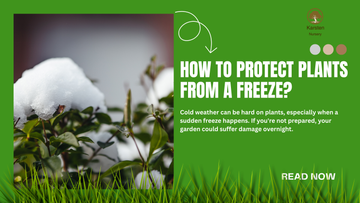
Cold weather can be hard on plants, especially when a sudden freeze happens. If you're not prepared, your garden could suffer damage overnight. The good news is that there are easy and effective ways to protect your plants from freezing temperatures.
With a little planning and the right steps, you can keep your garden safe and healthy all winter long. This guide will show you how!
How to Protect Potted Plants from Freezing Overnight?
Potted plants are extra vulnerable because their roots aren’t insulated from the ground. Protecting plants from freezing is simpler when they’re in containers—just move them!
Bring pots indoors or tuck them close to a warm house wall under cover. If that’s not possible, cluster them together and wrap the pots in blankets or burlap for plant freeze protection. Elevating them off concrete or stone also helps prevent cold conduction from below.
Quick-Specs: Potted Plant Freeze Prep
-
Ideal Temp Threshold: 32°F (0°C)
-
Moveable Pots: Best under 15 inches
-
Insulation Materials: Blankets, straw, burlap
-
Freeze Duration Protection: 1–3 nights
Can I Use Blankets to Cover My Plants from Frost?
Yes, covering plants to protect from frost using household items is cost-effective and quick.
Use lightweight blankets, sheets, or even towels. For frost protection for plants, drape them loosely over your garden greenery and secure with rocks or stakes—don't let them press down on delicate leaves.
How to Insulate Outdoor Plants During a Freeze?
Insulation keeps heat in and frost out. For plant protection from freeze, mulch is your best friend.
Pile 2–4 inches of straw, pine needles, or bark mulch around the base of plants. For bushy or leafy plants, consider wrapping them in burlap or placing a cardboard box over them overnight. Bubble wrap also creates a decent wind-blocking layer around planters.
When Should I Cover My Plants from Cold?

Timing is everything. Cover plants winter-style any time temps dip below 32°F.
Check the forecast for late fall. Protect plants in freeze conditions especially when there’s calm, clear weather—those nights often get the coldest.
Don’t cover too early in the day. Wait until just before sunset to trap the heat and uncover in the morning so they can breathe.
How to Protect Vegetable Garden from Freezing Temperatures?
Cold-hardy veggies can handle some frost, but not all of them. For true frost prevention for plants like tomatoes, peppers, and cucumbers, you’ll need to act fast.
Use row covers, frost blankets, or even upside-down buckets at night. Be sure to remove them each morning to let sunlight in.
For long-term snow protection for bushes and taller crops, build simple wooden frames and drape frost cloths over the top.
How to Shield Young Plants from Frost?
Young seedlings are especially at risk. They're tender and haven’t developed cold resistance. Cloches are great for protecting plants from freeze in early stages. Another trick? Place warm water jugs next to them under a cover—radiating heat helps a lot.
And if you’re asking, how can I protect plants from frost on short notice? Even a cardboard box will be in a pinch.
Should I Water Plants Before a Freeze?

Yes, watering plants before a freeze helps trap heat in the soil and keeps roots from dehydrating.
Moist soil retains warmth better than dry. Just avoid soaking them if temps are going to stay low for days—overly wet soil can freeze and damage roots.
If you’ve ever wondered, how do you protect plants from frost without fancy tools?—a watering can is your unexpected hero.
Best Plant Covers for Winter Protection
Want to level up blankets and buckets? Specialized covers work better and last longer.
Here are some top choices for covering plants for frost protection:
Quick-Specs: Best Winter Plant Covers
|
Product Type |
Coverage Area |
Material |
Ideal For |
|
Frost Cloth |
10–50 sq ft |
Breathable fabric |
Flower beds, veggies |
|
Garden Row Covers |
Varies |
Polypropylene |
Raised beds |
|
Cold Frame Boxes |
2–4 sq ft |
Glass or acrylic |
Seedlings, herbs |
|
Insulating Plant Jackets |
Varies |
Quilted wrap |
Potted shrubs |
When thinking about how to protect plants against frost, investing in the right gear makes each winter easier.
Final Thoughts
Protecting your plants from freezing doesn't have to be difficult. With a little care—like covering your plants, watering them before freezing, and choosing the right location—you can help them survive cold nights and thrive when warmer weather returns. Every step you take now helps your garden stay strong through the seasons.
Discover Karsten Nursery’s Hybrid Super Trees—specially grown for strength, growth, and year-round resilience. Whether you’re starting fresh or upgrading your garden, these trees are built to thrive in all kinds of conditions.
For more information, visit us and give your landscape the superpower it needs.
FAQs
1. What is the best thing to cover plants with during a freeze?
The best covers for frost protection are breathable fabrics like frost cloths, old bed sheets, burlap, or garden row covers. These materials trap heat while still allowing air circulation. For taller plants or bushes, plant jackets or insulated wraps work well. Avoid using plastic directly on foliage, as it can trap moisture and cause damage when it freezes.
2. Should you water plants before covering for a freeze?
Yes, you should water plants before a freeze. Moist soil retains heat better than dry soil, which helps protect the plant roots. Water early in the day so it has time to soak in before nighttime temperatures drop. Just avoid overwatering if a deep freeze is expected for multiple days.
3. Can you put plastic bags over plants to protect from frost?
Yes, but with caution. Plastic can be used as a temporary frost barrier, but it should never touch the leaves directly. Use stakes or a frame to create a small tent, keeping the plastic off the plant. For safer alternatives, use cloth covers or frost blankets, which are breathable and more plant-friendly.
4. What helps plants survive freezing temperatures?
Key strategies to help plants survive freezing temperatures include: Covering plants with frost cloths or blankets, Watering the soil before a freeze, Mulching around the base to insulate roots and Moving potted plants indoors or against warm structures.
5. How can you protect plants from frost?
You can protect plants from frost by covering them with breathable materials like old sheets, frost blankets, or even buckets and boxes overnight. Insulate the roots with mulch and, when possible, move container plants inside. For fragile plants, combining multiple methods—like covers plus warm water jugs—offers extra protection during cold snaps.
Read more relevant blogs as well. What Part of the Plant Produces Food for the Plant?
What Part of the Plant Produces Food for the Plant?




